Alarplasty is a specific type of rhinoplasty that aims to reshape the nostrils. It usually involves cutting part of the nostril cartilage (called “alae”) to change either the shape or size of your nasal opening and sides of the nose. Other terms for Alarplasty also include alar trimming, alar reduction and alar base reduction.
Dr Stephen Kleid is a highly experienced Melbourne ENT Surgeon performing Alarplasty at the Masada Hospital in St Kilda East.
Alarplasty: A Nose Reshaping Technique to Address Nostril Concerns
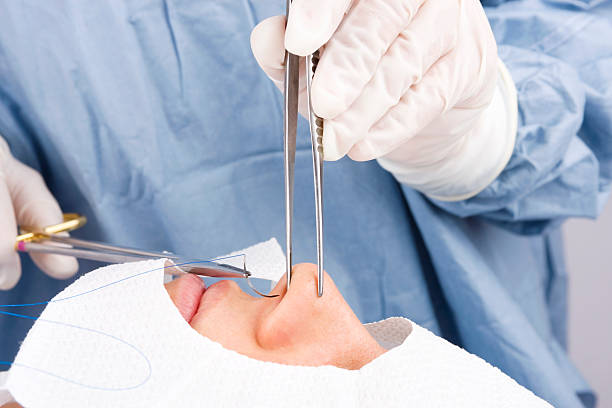
Alarplasty is a specialized procedure designed to address issues related to both the shape and appearance of the nostrils. The nose plays a prominent role in overall facial aesthetics as it is front and center. Even minor imbalances in the width, projection, or symmetry of the nose can significantly affect your overall facial harmony.
The nostrils, in particular, are crucial components of the nose. Their shape can vary in terms of curvature and size, as well as, proportion. Some individuals may have nostrils that appear either too curved, too straight, too large, too small, or possess an upward curve that can create an unintentional snarling appearance.
Dr. Kleid performs Alarplasty, a rhinoplasty technique specifically designed to correct and enhance the appearance of deformed or aesthetically displeasing nostrils.
As one of the leading ear, nose, and throat (ENT) surgeons in Melbourne, Dr. Kleid developed advanced techniques to provide patients with well-shaped nostrils that complement their other facial features.
By carefully addressing the specific concerns related to the nostrils, Dr Kleid can help restore facial symmetry and balance, ultimately improving overall facial aesthetics. Alarplasty offers a targeted solution to not only reshape, but refine the nostrils, harmonizing them with the rest of your facial features.
Anatomy of the Nose
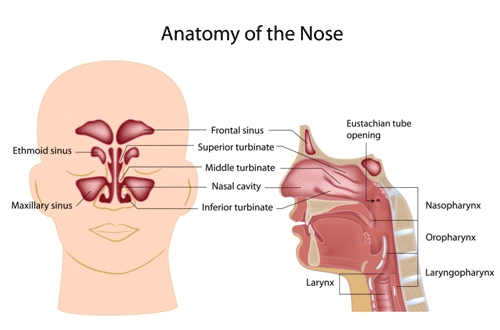
The nostrils have a core made of cartilage and is covered with skin. Cartilage refers to the flexible firm part of your nose.
The “alar base” is the imaginary horizontal line connecting the nostrils where they meet the cheeks.
The middle column separating the two nostrils is called the “columnella”, which also has a cartilage core.
The deformities related to the nostrils and alar cartilage can be summarized as:
Wide alae
This also translates to wide nostrils. In general, the ideal width of the nose should not exceed that of a single eye. Therefore, individuals that have anything wider may wish to change it.
If you have wide nostrils an alar base reduction may help.
Notched alae
We also call this nasal flaring. It’s when the sides of your nostrils are notched up, and therefore the columnella is visible from a profile view. Unfortunately, this can make it appear as if you are snarling. But, an Alarplasty can help the appearance of this nasal flaring.
Alar asymmetry
In other words, your nostrils might look different. One nostril may be larger than the other, or the shape may be visibly different, an Alarplasty, can alleviate the appearance of uneven nostrils.
Consultation
During your consultation with Dr Kleid, he will conduct a comprehensive evaluation of your nose and facial structure.
He will discuss your overall health, desired outcomes and surgical options. Then, he will create a personalized treatment plan tailored to your unique needs.
Dr Kleid’s extensive experience and meticulous approach ensure that each patient receives not only the highest level of care, but natural-looking, desirable results.
If you are considering Alarplasty or have concerns about the appearance of your nostrils, we encourage you to schedule a consultation with Dr Kleid. Take the next step towards achieving a more balanced and harmonious facial appearance, knowing you are in the hands of a skilled ENT surgeon dedicated to delivering exceptional outcomes.
Alarplasty: A Procedure to Enhance Nostril Appearance
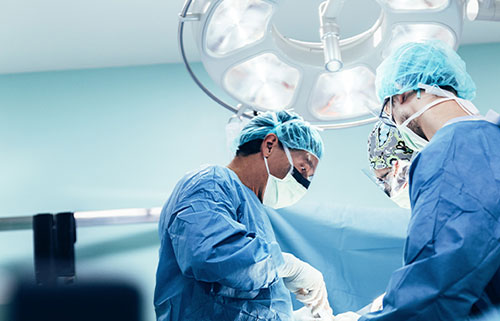
Alarplasty is a surgical procedure that addresses concerns related to either the shape and/or size of the nostrils. It can be performed as either a standalone procedure or in conjunction with other rhinoplasty techniques to achieve a more comprehensive nose job. The decision to combine Alarplasty with other procedures will depend on your specific goals, the desired outcome, and also your surgeon’s advice.
Dr Kleid will perform the surgery under General Anesthesia. He will create 2 or 3 incisions. The location of the incisions are right below your nose, where the nostrils meet the face/cheeks. One incision under each nostril, and one under the columnella.
This allows Dr Kleid to have access to the deeper tissue of the nostrils; the alar cartilage.
Dr Kleid will then perform any combination of the following techniques to reshape your nostrils:
- Bring the sides closer to the middle to make your nose and nostrils narrower. This is done to fix wide nostrils.
- Bring your columnella up, and alar cartilage down, to fix the “snarling” appearance (notched nostrils).
- Cut out a piece of the alar cartilage to reduce curvature and make the nostrils narrower
Once Dr Kleid is happy with the results, he will use very fine sutures to close the skin incisions under your nose.
Since the incisions are made along natural skin creases, they are usually easily disguised in the skin crease.
Potential Benefits of Alarplasty Surgery
Alarplasty can offer the following benefits:
- Narrowing the Nostrils:
- By modifying the width of the nostrils, Alarplasty can create a more proportionate appearance.
- Enhancing Nostril Curvature:
- The procedure can either add or reduce curvature to the sides of the nose, achieving a desired aesthetic outcome.
- Straightening Nostril Shape:
- Alarplasty can correct any asymmetry or irregularities in the shape of the nostrils, resulting in a more balanced look.
- Widening the Nostrils:
- In certain cases, widening the nostrils may be desired to improve breathing or address specific aesthetic concerns.
- Correcting Notched Nostrils:
- Alarplasty can address notched nostrils by repositioning the sides of the nostrils to cover any protruding middle portion.
- Correcting Nostril Asymmetry:
- Alarplasty can help address asymmetry issues by reshaping the nostrils to create better symmetry and balance.
- Alleviating Breathing Issues:
- In some cases, Alarplasty may also help nasal airflow and alleviate breathing difficulties caused by structural abnormalities.
It is important to note that the exact techniques used in Alarplasty will vary based on individual factors and the desired results.
Nose Before and After Gallery
See more of Dr Stephen Kleid’s previous nose surgery patients before and after surgery
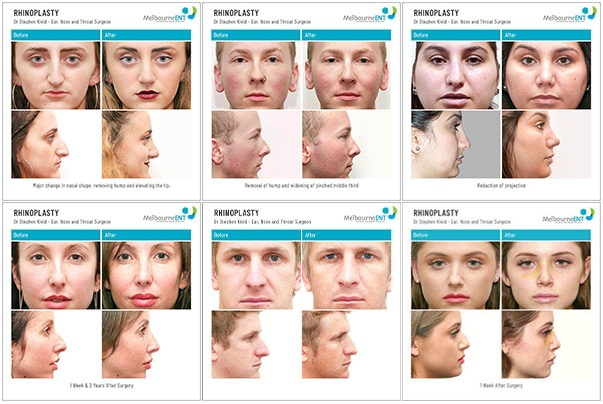
Recovery After Alarplasty
After undergoing an Alarplasty, it is important to follow a proper recovery process to ensure optimal healing and results. Below is a general summary of the Alarplasty recovery period, however, each patient’s recovery will vary:
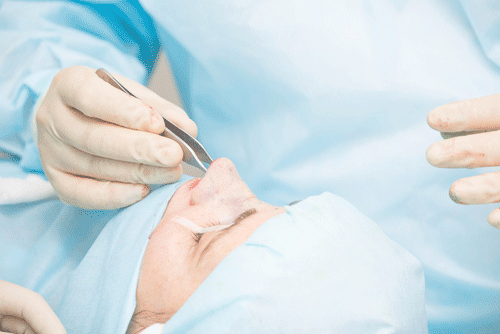
- Immediately After Surgery:
- You will be closely monitored in a recovery area.
- Your nose may be covered with either a splint or bandages to provide support and protection.
- You will likely experience some swelling, bruising, and discomfort during this initial phase.
- First Few Days:
- It is normal to experience some swelling and bruising around both the nose and eye area.
- Pain medication prescribed by your surgeon can help manage any discomfort.
- It is crucial to keep your head elevated and avoid any activities that can strain your nose.
- Swelling and Bruising:
- Both swelling and bruising are common after Alarplasty and will gradually subside over the next few weeks.
- Applying cold compresses to the affected area as recommended by your surgeon can help reduce swelling.
- Stitches Removal:
- If non-absorbable stitches were used, they will typically be removed within a week after the surgery.
- Your surgeon will provide instructions on when and how to have the stitches removed.
- Physical Activity:
- It is essential to avoid any strenuous activities, exercise, and heavy lifting for several weeks to prevent complications and allow proper healing.
- Nasal Care:
- Your surgeon will provide instructions on how to care for your nose during the recovery period.
- This may include keeping the surgical site clean, using saline sprays or nasal irrigations as recommended, and avoiding any nasal trauma.
- Follow-up Appointments:
- You will have scheduled follow-up appointments with your surgeon to monitor your healing progress and address any concerns or questions you may have during the recovery process.
- Healing and Results:
- It takes time for the swelling to fully subside, and the final results of Alarplasty may take several months to become apparent.
- It is essential to be patient and follow your surgeon’s post-operative instructions for optimal healing and long-term results.
Remember, every individual’s recovery process may vary, and it is crucial to follow your surgeon’s specific guidelines and recommendations for a successful Alarplasty recovery. If you have any concerns or experience unexpected symptoms during your recovery, it is important to contact your surgeon promptly.
What is The Cost of Alarplasty in Melbourne?

The cost of alarplasty surgery in Melbourne depends on several factors, including the surgeon’s expertise, the complexity of the procedure and any additional fees associated with the surgery. It is best to consult with a qualified surgeon to get an accurate estimate of the cost.
During a consultation, your surgeon will evaluate your specific case and discuss your desired outcome. They will provide you with a comprehensive quote that includes the surgeon’s fees, anesthesia fees, facility fees, as well as, any other associated costs.
It is important to consider that the total cost of Alarplasty surgery may also include pre-operative consultations, post-operative care, and any necessary follow-up appointments.
It is recommended to thoroughly discuss the costs involved with your chosen surgeon and ensure that you have a clear understanding of what is included in the quote.
Remember, while cost is an important consideration, it is equally important to choose a highly skilled and experienced surgeon who prioritizes patient safety and delivers satisfactory results.
Frequently Asked Questions
Is Alarplasty part of rhinoplasty?
Alarplasty is a special rhinoplasty technique. It’s technically rhinoplasty that’s directed at a specific part of the nose – the alar cartilage (nostrils). Therefore, it can be done alone or in combination with other rhinoplasty techniques.
Does Alarplasty affect breathing?
Although the nostrils might be narrowed with alar base reduction, they won’t be altered to the point where they will affect airflow.
How long does Alarplasty take to heal?
Typically, recovery after Alarplasty can take between 2-3 weeks and a few months.
You can generally go back to work after 5-7 days.
You will need to wait a before you get the all clear from the surgeon before you resume sports.
How can I reduce the size of my nose?
Rhinoplasty (nose reshaping surgery) is the only way to reduce the size of your nose.
If a specific part of your nose is too big (like the nostrils or tip) then you can opt for less extensive nose surgery, namely Tipplasty and nostril reshaping surgery.
How can I reduce my nose size naturally?
There’s no way to reduce the nose size without surgery.
What is alar trimming?
Alar trimming is another name for alarplasty or Alar Base Reduction. It signifies the fact that the alar cartilage is “trimmed” during the surgery to be reshaped.
Why are my nostrils so big?
The nostrils can be big due to excessive outer curvature of the nostril walls, which is a result of having big alar cartilage.
Medical References and Sources:
- Incidence of Alarplasty in primary and revision rhinoplasty in a private practice setting
- Alar Base Reduction and Alar-Columellar Relationship
- Nasal base reduction: a treatment algorithm including alar release with medialization
- Update in alar base reduction in rhinoplasty
- Alar base reduction: the boomerang-shaped excision





